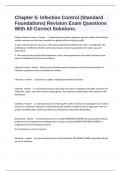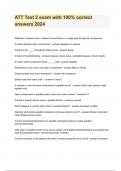Chapter 5: Infection Control (Standard
Foundations) Revision Exam Questions
With All Correct Solutions.
Explain Infection Control - Answer 1. State boards and other regulatory agencies require that infection
control measures and safe work practices be applied while serving the public.
2. Since transmission can also occur when using contaminated implements, tools, or equipment, the
performance of effective infection control procedures must be top priority in the salon, spa, and
barbershop.
3. Safe work practices require that implements, tools, and equipment be used safely and that you be
aware of situations that can cause accidents.
Infection Control - Answer Refers to the methods used to eliminate or reduce the transmission of
infectious organisms from one individual to another
Infectious - Answer Caused by or capable of being transmitted by infection
Cleaning - Answer Is a mechanical process using soap and water or detergent and water to remove all
visible dirt, debris, and many disease-causing germs. Also removes invisible debris that interferes with
disinfection
Sanitizing - Answer Is a chemical process of reducing the number of disease-causing germs on cleaned
surfaces to a safe level. Infection control professionals consider sanitation to be a layperson's term or a
product marketing term, preferring cleaning to describe the step before disinfecting
Disinfecting - Answer A chemical process for use with NONPOROUS ITEMS that uses specific products
to destroy harmful organisms including bacteria, viruses, and fungi (EXCEPT BACTERIA SPORES) on
implements and environmental surfaces.
Ex of nonporous: scissors, tweezers
Sterilizing - Answer The process that destroys all microbial life, INCLUDING SPORES, generally with the
use of an autoclave.
,Ex of Porous: Pumice stone
Beauty professionals should study and have a thorough understanding of infection control because: -
Answer 1. It is important to know about the pathogens professionals and their clients may be exposed
to and their modes of transmission.
2. Understanding and practicing proper infection control within the laws and rules will help safeguard
professionals' health, the health of their clients, and their business
3. Practicing safety precautions on a daily basis protects their clients and their license
4. A responsible beauty professional is conscientious about infection control and safety
Federal Agencies - Answer Set guidelines for the manufacture, sale, and use of equipment and
chemical ingredients. These guidelines also monitor safety in the workplace and place limits on the types
of services you can perform in a salon, spa, or barbershop.
State Agencies - Answer Regulate licensing, enforcement, and your conduct when you are on the job
Occupational Safety and Health Administration (OSHA) - Answer Was created as part of the U.S.
Department of Labor to regulate and enforce safety and health standards to protect employees in the
workplace. Address issues relating to the handling, mixing, storing, and disposing of products; general
safety in the workplace; and your right to know about any potentially hazardous ingredients contained in
the products and how to avoid these hazards. Requiring that chemical manufacturers and importers
assess and communicate the potential hazards associated with their products through a Safety Data
Sheet (SDS).
Safety Data Sheet (SDS) - Answer A 16-category, standard-format document that replaces the
previously mandated MSDS or PSDS that assess and communicates the potential hazards associated with
products
Environmental Protection Agency (EPA) - Answer Registers all types of disinfectants sold and used in
the United States.
A. It is against federal law to use any disinfecting product in a way contrary to the use indicated on its
label
B. Before manufacturers can sell a product for disinfecting surfaces, tools, implements, or equipment,
they must obtain an EPA registration number (indicated on a product label by "EPA Reg. No." near the
, manufacturer's name) that certifies that the disinfectant, when used correctly, will be effective against
the pathogens listed on the label.
C. Follow the label instructions for mixing, contact time, and the type of surface the disinfecting product
can be used on
Disinfectants - Answer Are chemical products that destroy most bacteria (excluding spores), fungi, and
viruses on surfaces.
1. Are not listed as "hospital grade" but instead are listed based on the pathogens they are effective
against
a. Products on list D meet the criteria of most states for hospital disinfectants
b. Products on list E meet the criteria of a tuberculocidal in those states where that is required
State Regulatory Agencies - Answer exist to protect beauty professionals' and their customers' health
and safety during services.
1. Include licensing agencies, state boards, commissions, and health departments
2. Enforcement of the rules through inspections and investigations of consumer complaints is also part of
an agency's responsibility.
3. Penalties vary and include warnings, fines, probation, and suspension or revocation of licenses
Laws - Answer are written by both federal and state legislatures to determine the scope of practice
(what each license allows the holder to do) and establish guidelines for regulatory agencies to make
rules. Laws are also called statues.
Rules and regulations - Answer Are more specific than laws. The regulatory agency or the state board
writes the rules and determines how the law must be applied. Rules establish specific standards of
conduct and can be changed or updated frequently.
Disease - Answer any abnormal condition of all or part of the body, its systems, or its organs that makes
body incapable of carrying on normal functions
Infection - Answer the invasion of body tissues by disease-causing pathogens.
a. preventing the spread is possible when you know proper procedures and follow them at all times
b. effective infection control also influences the professional image of your establishment






